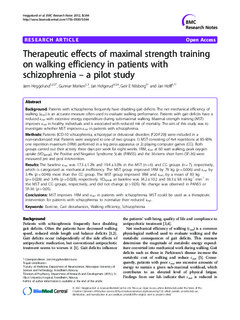| dc.contributor.author | Heggelund, Jørn | |
| dc.contributor.author | Morken, Gunnar | |
| dc.contributor.author | Helgerud, Jan | |
| dc.contributor.author | Nilsberg, Geir Erling | |
| dc.contributor.author | Hoff, Jan | |
| dc.date.accessioned | 2018-01-03T10:04:38Z | |
| dc.date.available | 2018-01-03T10:04:38Z | |
| dc.date.created | 2013-02-15T13:15:24Z | |
| dc.date.issued | 2012 | |
| dc.identifier.issn | 1756-0500 | |
| dc.identifier.uri | http://hdl.handle.net/11250/2474288 | |
| dc.description.abstract | Background
Patients with schizophrenia frequently have disabling gait deficits. The net mechanical efficiency of walking (ϵ net ) is an accurate measure often used to evaluate walking performance. Patients with gait deficits have a reduced ϵ net with excessive energy expenditure during sub-maximal walking. Maximal strength training (MST) improves ϵ net in healthy individuals and is associated with reduced risk of mortality. The aim of this study was to investigate whether MST improves ϵ net in patients with schizophrenia.
Methods
Patients (ICD-10 schizophrenia, schizotypal or delusional disorders (F20-F29)) were included in a non-randomized trial. Patients were assigned to one of two groups: 1) MST consisting of 4x4 repetitions at 85-90% one repetition maximum (1RM) performed in a leg press apparatus or 2) playing computer games (CG). Both groups carried out their activity three days per week for eight weeks. 1RM, ϵ net at 60 watt walking, peak oxygen uptake (VO2peak), the Positive and Negative Syndrome Scale (PANSS) and the 36-items short form (SF-36) were measured pre and post intervention.
Results
The baseline ϵ net was 17.3 ± 1.2% and 19.4 ± 3.0% in the MST (n = 6) and CG groups (n = 7), respectively, which is categorized as mechanical inefficiency. The MST group improved 1RM by 79 kg (p = 0.006) and ϵ net by 3.4% (p = 0.046) more than the CG group. The MST group improved 1RM and ϵ net , by a mean of 83 kg (p = 0.028) and 3.4% (p = 0.028), respectively. VO2peak at baseline was 34.2 ± 10.2 and 38.3 ± 9.8 ml·kg-1·min-1 in the MST and CG groups, respectively, and did not change (p > 0.05). No change was observed in PANSS or SF-36 (p > 0.05).
Conclusions
MST improves 1RM and ϵ net in patients with schizophrenia. MST could be used as a therapeutic intervention for patients with schizophrenia to normalize their reduced ϵ net . | nb_NO |
| dc.language.iso | eng | nb_NO |
| dc.publisher | BioMed Central | nb_NO |
| dc.rights | Navngivelse 4.0 Internasjonal | * |
| dc.rights.uri | http://creativecommons.org/licenses/by/4.0/deed.no | * |
| dc.title | Therapeutic effects of maximal strength training on walking efficiency in patients with schizophrenia - a pilot study | nb_NO |
| dc.type | Journal article | nb_NO |
| dc.type | Peer reviewed | nb_NO |
| dc.description.version | publishedVersion | nb_NO |
| dc.source.volume | 5 | nb_NO |
| dc.source.journal | BMC Research Notes | nb_NO |
| dc.identifier.doi | 10.1186/1756-0500-5-344 | |
| dc.identifier.cristin | 1010994 | |
| dc.description.localcode | © 2012 Heggelund et al.; licensee BioMed Central Ltd. This is an Open Access article distributed under the terms of the Creative Commons Attribution License (http://creativecommons.org/licenses/by/2.0), which permits unrestricted use, distribution, and reproduction in any medium, provided the original work is properly cited. | nb_NO |
| cristin.unitcode | 194,65,30,0 | |
| cristin.unitcode | 194,65,35,0 | |
| cristin.unitcode | 194,65,25,0 | |
| cristin.unitname | Institutt for nevromedisin og bevegelsesvitenskap | |
| cristin.unitname | Institutt for psykisk helse | |
| cristin.unitname | Institutt for sirkulasjon og bildediagnostikk | |
| cristin.ispublished | true | |
| cristin.fulltext | original | |
| cristin.qualitycode | 1 | |

